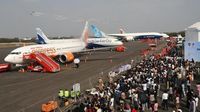In a year marked by technological leaps and bold visions for the future of flight, two major developments are reshaping the narrative around urban air mobility in both the United States and India. On August 16, 2025, Joby Aviation made headlines by completing the first-ever piloted electric vertical takeoff and landing (eVTOL) aircraft flight between two public airports in the US. Meanwhile, India’s Ministry of Civil Aviation announced that Wings India 2026, Asia’s largest civil aviation event, will spotlight Advanced Air Mobility (AAM) technologies—heralding a new era for aviation in the subcontinent and beyond.
Joby Aviation’s milestone flight took off from Marina Municipal Airport (OAR) and landed at Monterey Regional Airport (MRY) in California, covering roughly 10 nautical miles in a swift 12 minutes. The journey wasn’t just a straight shot; the pilot executed a vertical takeoff, transitioned into forward flight, and performed a vertical landing at the destination. To safely integrate with other arriving aircraft, Joby’s pilot even entered a five-minute holding pattern over Monterey—a maneuver that demonstrated the eVTOL’s ability to coexist with traditional commercial air traffic in controlled FAA-managed airspace.
The significance of this event wasn’t lost on industry watchers. According to Mathrubhumi, "Successfully flying from Marina to Monterey showcased our aircraft integrated into the broader transportation network and further proved its readiness for commercial service," said Didier Papadopoulos, President of Aircraft OEM at Joby Aviation. The flight marks the first time in the US that a piloted eVTOL has operated between two public airports, and it’s a crucial step toward securing FAA certification for commercial operations.
Joby’s rigorous flight test program has already logged more than 40,000 miles, underscoring the company’s commitment to safety and reliability. The recent milestone adds to a growing list of achievements, as Joby has begun the final assembly of its first aircraft intended for Type Inspection Authorisation testing—one of the last hurdles before full FAA certification. According to the company, test flights with FAA pilots are expected to begin early next year, with commercial services initially planned for major urban centers like Los Angeles and New York City.
This technological progress isn’t just an American story. The implications for densely populated countries with rapidly growing urban centers are profound. In India, cities like Mumbai, Bengaluru, and Delhi are infamous for their gridlocked roads and long commutes. As Mathrubhumi notes, eVTOL technology could "offer a much faster, cleaner alternative to road travel," potentially whisking passengers across sprawling metropolises in a fraction of the time it currently takes by car. With a burgeoning middle class and increasing demand for premium, time-saving transportation, India is seen as fertile ground for air taxi adoption—if the regulatory and infrastructure pieces fall into place.
Enter Wings India 2026. On the same day as Joby’s historic flight, India’s Ministry of Civil Aviation announced that its flagship biennial event will serve as a showcase for the country’s aviation growth and a platform to highlight cutting-edge AAM technologies. Scheduled for January 28 to 31, 2026, at Hyderabad’s Begumpet Airport, Wings India is positioned as Asia’s largest civil aviation gathering. The event will bring together global stakeholders for exhibitions, technical sessions, roundtables, and high-level dialogues, all aimed at shaping the future of flight in India.
According to The Hindu, Advanced Air Mobility encompasses a range of next-generation aircraft technologies—often electric, hybrid, or autonomous—that promise short- and medium-distance transport in both urban and rural settings. This includes not just air taxis and eVTOLs, but also drone-based logistics that could revolutionize everything from medical supply delivery to disaster response and last-mile connectivity. These innovations are closely aligned with global sustainability goals, as they typically rely on low-emission or zero-emission propulsion systems.
India’s Civil Aviation Minister, K. Rammohan Naidu, emphasized the strategic importance of AAM during a recent session of the Lok Sabha. He explained that while no direct regulatory clearances or financial incentives have yet been finalized under the Wings India 2026 banner, the event will be a catalyst for policy discussions, technology showcases, and pilot demonstrations. The aim is to foster collaboration among state governments, original equipment manufacturers (OEMs), regulators, and other stakeholders to identify viable use cases and develop the regulatory frameworks needed to bring AAM to fruition.
"Wings India will provide a platform for AAM, which is emerging globally as the next frontier in air transport technology," Minister Naidu stated, as reported by The Hindu. The event’s objectives are ambitious: attract investment into India’s aviation ecosystem, nurture innovation in digital aviation, safety, and sustainability, and connect domestic and international players in a rapidly evolving sector.
The timing could hardly be better. As the world grapples with urban congestion, environmental concerns, and the need for resilient transportation networks, the promise of eVTOLs and AAM technologies is drawing serious attention. In India, the potential applications are vast: imagine drones delivering blood supplies to remote clinics, air taxis bypassing rush-hour traffic, or rapid-response aircraft aiding disaster relief in hard-to-reach areas. With ongoing engagement between government bodies, industry leaders, and investors, the groundwork is being laid for a future in which the skies above India’s cities are as busy—and as vital—as its roads are today.
Of course, challenges remain. Infrastructure investments in vertiports, charging stations, and airspace management systems will be essential. Regulatory clarity and public acceptance will also play a crucial role in determining how quickly these new modes of transport can scale. But as the success of Joby Aviation’s US flight demonstrates, the technology is maturing rapidly, and the vision of urban air mobility is moving from science fiction to practical reality.
Wings India 2026 is expected to serve as a bellwether for the region, offering a glimpse into a future where advanced air mobility reshapes not just how people travel, but how cities function and grow. With both the US and India pushing the envelope, the next decade could see a dramatic transformation in global aviation—one where the sky is no longer the limit, but the new frontier for everyday mobility.
